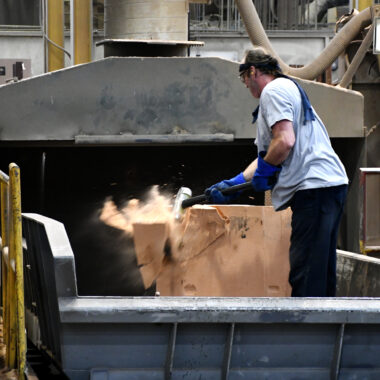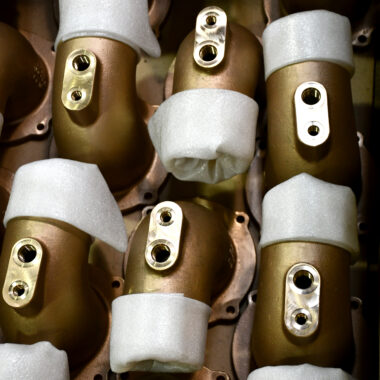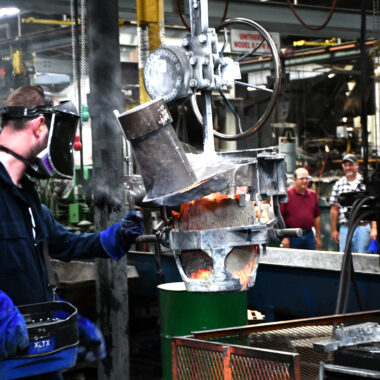Crafting Radiance: Browsing the Globe About Aluminum Casting
Crafting Radiance: Browsing the Globe About Aluminum Casting
Blog Article
Crafting Excellence: How to Achieve High-Quality Aluminum Castings Every Time
In the realm of light weight aluminum casting, the quest of excellence is a continual journey that needs a precise method and an eager understanding of the complexities entailed. Achieving constant top quality light weight aluminum spreadings demands a thorough grasp of the procedures, from choosing the proper alloy to executing specific mold and mildew styles and thoroughly regulating casting specifications.
Recognizing Aluminum Casting Procedures
Aluminum casting processes, crucial in the production market, entail the elaborate makeover of molten aluminum right into strong types through a collection of meticulously regulated actions. Recognizing these procedures is critical to achieving high-grade light weight aluminum spreadings regularly - about aluminum casting. The key methods made use of in aluminum spreading are die casting, sand casting, and investment spreading

Each of these procedures has its benefits and is chosen based upon variables like complexity, volume, and preferred surface of the light weight aluminum spreading. about aluminum casting. Comprehending the ins and outs of these methods is critical for makers intending to produce top notch light weight aluminum spreadings consistently
Choosing the Right Aluminum Alloy
Selecting the appropriate light weight aluminum alloy is an important choice in the production of top quality aluminum castings. When selecting a light weight aluminum alloy for casting, it is important to think about the particular requirements of the application to make sure optimal performance.
One of the most commonly used aluminum alloys for casting is A356 - about aluminum casting. For applications needing high stamina, 7075 aluminum alloy is a popular choice due to its outstanding strength-to-weight ratio.
In enhancement to mechanical buildings, considerations such as expense, accessibility, and post-casting procedures need to likewise influence the selection of the appropriate aluminum alloy. By thoroughly assessing these elements, makers can make sure the manufacturing of high-grade aluminum castings that satisfy the preferred specifications.
Executing Appropriate Mold And Mildew Design
Creating a reliable mold and mildew design is essential for making sure the successful production of high-grade light weight aluminum spreadings. Appropriate mold design plays a substantial role in accomplishing the preferred features of the final item. To execute an effective mold and mildew layout, factors such as material circulation, cooling down prices, and component geometry have to be meticulously thought about.
One trick aspect of mold and mildew layout is ensuring correct dental filling and solidification of the aluminum click here now within the mold tooth cavity. This entails creating runner and gating systems that assist in smooth steel flow and avoid problems such as air entrapment or insufficient filling. In addition, including cooling channels into the mold and mildew style helps regulate solidification rates and lower the risk of porosity or shrinking flaws.

Controlling Casting Parameters

Making Sure Post-Casting High Quality Checks
To keep the excellent quality of aluminum spreadings, complete post-casting quality checks are necessary. After the spreading process is finished, it is crucial to make certain that the final products satisfy the preferred requirements and standards. Among the key high quality checks involves checking the surface coating of the castings to identify any issues such as porosity, splits, or surface area irregularities. This visual assessment is frequently supplemented by non-destructive screening approaches like ultrasonic screening or dye penetrant assessment to identify interior problems that might jeopardize the honesty of the casting.
Dimensional precision is an additional important element that has to be verified throughout post-casting top quality checks. Measurements of vital measurements and resistances need to be taken to validate that the spreadings comply with the called for specifications. Furthermore, mechanical homes such as firmness, tensile toughness, and influence resistance might require to be assessed with product testing to make sure that the spreadings possess the necessary strength and durability for their designated application.
Verdict
Finally, achieving top notch light weight aluminum spreadings requires a thorough understanding of the spreading procedures, selecting the ideal alloy, creating mold and mildews successfully, regulating casting specifications carefully, and conducting post-casting top quality checks faithfully. By adhering to these actions, suppliers can continually produce light address weight aluminum spreadings that meet the highest possible requirements of high quality and performance.
Accomplishing consistent top quality light weight aluminum spreadings demands a detailed understanding of the procedures, from picking the ideal alloy to carrying out precise mold styles and thoroughly controlling spreading specifications. The key techniques made use of in aluminum casting are pass away spreading, sand spreading, and financial investment casting.
Investment spreading, additionally understood as accuracy casting, entails developing wax patterns that are covered in ceramic to develop molds.Selecting the ideal aluminum alloy is a critical decision in the manufacturing of high-grade aluminum castings.Making sure precise control over spreading specifications is necessary for preserving uniformity and top quality in aluminum spreading manufacturing.
Report this page